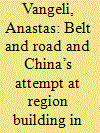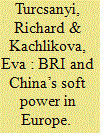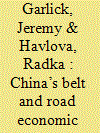|
|
|
Sort Order |
|
|
|
Items / Page
|
|
|
|
|
|
|
| Srl | Item |
| 1 |
ID:
178212


|
|
|
|
|
| Summary/Abstract |
This article analyses China’s Belt and Road as a medium through which novel regional development ideas and practices are being generated, (re)articulated, and diffused, via a case study of its implementation in the broader region of Central-East and Southeast Europe (CESEE). The example of CESEE shows that via the Belt and Road, Chinese actors have advanced comprehensive region work based on social interactions, which includes regular high-level diplomatic exchange and quasi-institutionalisation as well as people-to-people relations, resting on the potent geoeconomic imaginaries of the New Silk Roads. This approach, in the case of CESEE, has allowed for regional co-operation to advance even in times of friction and uncertainties. Nevertheless, as region work is essentially a contentious endeavour, China’s attempt at regionalism in CESEE has been challenged by the European Union (EU), the United States and regional actors who feel uneasy about China’s advance.
|
|
|
|
|
|
|
|
|
|
|
|
|
|
|
|
| 2 |
ID:
178213


|
|
|
|
|
| Summary/Abstract |
The Russian-led Eurasian Economic Union (EAEU) is a key partner in China’s Belt, and Road Initiative (BRI), since it comprises the majority of territories which the BRI’s overland route, the Silk Road Economic Belt, needs to traverse as it crosses Central Asia on the way to Europe. The goal of this article is to explore the BRI in the context of BRI–EAEU coordination. The first part of the analysis focusses on the ways the Eurasian Economic Commission delineates the “Greater Eurasian Partnership” and counterposes it against China and the BRI. Then, the article compares two sets of interpretations of the BRI and “Greater Eurasian Partnership” obtained from interviews with elites in Kazakhstan and Russia. The interviews indicate that the BRI has had a much more forceful impact on local elites than Russia’s idea of “Greater Eurasian Partnership.”
|
|
|
|
|
|
|
|
|
|
|
|
|
|
|
|
| 3 |
ID:
178214


|
|
|
|
|
| Summary/Abstract |
The article aims to contribute to our understanding of China’s soft power in Europe and the impact of the Belt and Road Initiative (BRI) in this regard. We conduct analyses of two leading newspapers in the United Kingdom, in Spain, and in Poland to discover how the BRI was framed there in the period from mid-2013 to mid-2017. The empirical results show that the media reported about the initiative quite positively – especially compared to the general media picture of China in Europe – and to a considerable extent followed Chinese narratives of economic opportunities while overlooking geopolitical and security worries. Theories of “journalistic routines” and linguistic “affective sticking points” will be suggested as possible explanations of these dynamics, highlighting both the fact that Chinese narratives outnumbered European ones in the initial period quantitatively, and were able to offer something that resonated with the audience qualitatively.
|
|
|
|
|
|
|
|
|
|
|
|
|
|
|
|
| 4 |
ID:
178215


|
|
|
|
|
| Summary/Abstract |
Drawing on the literature on strategic hedging and adapting it to China’s use of economic diplomacy in the service of comprehensive national security goals within the regionalised foreign policy approach of the Belt and Road Initiative (BRI), we examine China’s approach to securing and expanding its interests in the Persian Gulf. To implement the trade and infrastructure connectivity goals of the BRI and to secure the continued flow of diversified energy supplies, China needs to boost relations with both regional powerhouses, Iran and Saudi Arabia, without alienating either of them or the regional hegemon, the United States. The resulting strategy of strategic hedging is based in the Chinese approach to economic diplomacy, which utilises Chinese commercial actors in the service of national strategic objectives. Relations require careful and ongoing management if China is to achieve outcomes which benefit all sides while avoiding becoming entangled in the region’s intractable geopolitical problems.
|
|
|
|
|
|
|
|
|
|
|
|
|
|
|
|
| 5 |
ID:
178216


|
|
|
|
|
| Summary/Abstract |
To mitigate the risks and maximise the opportunities arising from China’s great power behaviour, Malaysia employed a hedging strategy during Mahathir Mohamad’s second term as prime minister. From 2018 until 2020, the middle power Malaysia applied direct engagement and elements of limited balancing and limited bandwagoning in a flexible yet consistent manner. Neither China’s Belt and Road Initiative (BRI) nor its actions in the South China Sea caused a sea change in Malaysia’s hedging strategy. Crucially, the policies towards China were embedded in omnidirectional, friendly, and well-balanced relations with the United States, Japan, and the Association of Southeast Asian Nations (ASEAN). Theoretically, this contribution applies an updated concept of hedging, initially introduced by Cheng-Chwee Kuik. As an important innovation, it adds a specific component to assess the perceptions of the political leader(s) of risks and opportunities related to the hedging target as well as the strategic value of potential balancing partners.
|
|
|
|
|
|
|
|
|
|
|
|
|
|
|
|
|
|
|
|
|